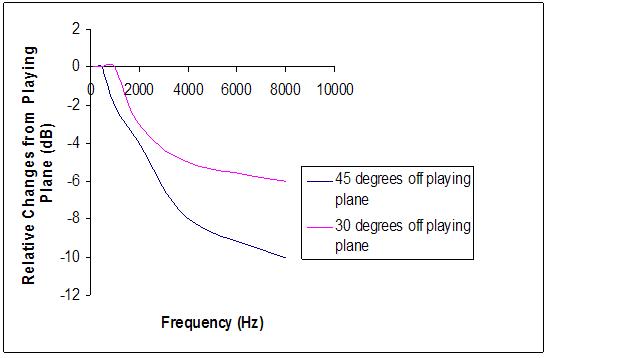Other than the title being a great joke (at the expense of our brass colleagues), there is some semblance of truth to it. Musicians (i.e. everyone in the orchestra) sit downwind of the trumpets and frequently have to bear the brunt of loud blasts on a regular basis. Other than sticking a sock in the trumpet bell, what can be done?
The most used strategy is to place trumpet players on risers. This is a suggestion that is equally applicable for high school band classes as professional orchestras. High school band classes can steal a riser from the drama department and since drama people are wimpy compared with the macho brass players, I doubt whether there will be any problem.
This figure (adapted from Musicians and the Prevention of Hearing Loss, M. Chasin, ed., 2009, Plural Publishing) shows the relative loss of higher frequency energy from the trumpet when measured off the playing plane. If one were to measure the sound pressure directly in line with the trumpet and then compare that with a measurement made 30 or 45 degrees above or below, there would be a loss of energy BUT only for the higher frequency sounds. This is also the case with loudspeakers- the higher frequencies emanate from the trumpet (or loudspeaker) in an almost straight line “laser-like” fashion. In the case of the trumpet player, the sound level is easily reduced by 6-9 dB at 4000 Hz (near the top note on the piano keyboard). This means that the damage can be reduced by a factor of 1/4 to 1/8 as if listened to on the playing plane of the trumpet.
This strategy must be coupled with the fact that most of the damaging sound in a trumpet is in the mid to higher frequency range. So, elevating the trumpet on risers literally reduces the potential for sound damage (and irritation) downwind. They also like it because everyone gets to see them!
This is an experiment that you can try yourselves. Using any inexpensive sound level meter (including the sound level app for the ipod, and its i-cousins, which is amazingly accurate) measure a low frequency sound from the trumpet on the playing plane, above, below, behind,… and you will notice that there really isn’t much difference. The trumpet (like our vocal tract for the speech scientists out there) is not a waveguide for the lower frequency sounds. For low frequency sounds, the trumpet simply is non-directional. Performing the same experiment for a high frequency sound will give a different picture.
This is also why loudspeakers (or monitor) should be aimed at the listener. The listener gets a flatter response and typically at a lower sound pressure level than if the speaker was sitting flat on the floor.







